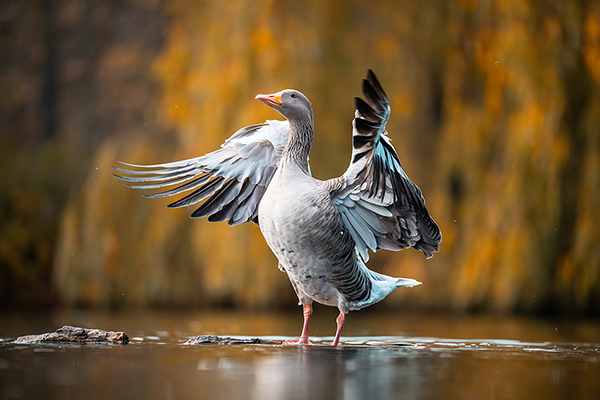Tamron Blogs
More Photo Tips | Video Gallery | Photo Gallery | Enewsletter sign-up
Understanding Image Stabilization: A Guide to Sharper Photography
Stability is essential to capture sharp images and smooth video footage. However, handheld shooting in low light environments or with long lenses, can result in camera shake that creates blurry images or shaky videos. This is where image stabilization comes into play, offering a solution to eliminate camera shake for sharper, clearer results.
What is Image Stabilization and What Does Image Stabilization Do?
Image stabilization (IS) is designed to reduce the effects of camera shake when capturing handheld photos and videos. Image stabilization compensates for unwanted movement or vibration, which can occur from shaky hands, unstable shooting conditions, or the use of ultra-telephoto focal length settings.
How Does Image Stabilization Work?
The fundamental principle behind image stabilization involves sensors detecting motion and then counteracting it by moving optical elements within the lens or the camera body itself. Tamron’s unique VC (Vibration Compensation) mechanism is a proprietary technology that utilizes a combination of specialized actuators and advanced algorithms to ensure a stable viewfinder image with precise tracking capabilities. The mechanism uses a 3-coil system that leverages electromagnetic forces to drive specific lens elements, effectively counteracting any vibrations or movements that occur during shooting or filming. The lens element that is responsible for stabilization is mounted on three balls to facilitate smooth movement with minimal friction. This design not only helps to achieve stability, but it also contributes to the compactness of Tamron lenses.
What Types of Image Stabilization Are there?
What is Optical Image Stabilization (OIS): This type of stabilization is built directly into the lens or camera lens system. It typically involves moving lens elements to compensate for detected motion. Optical Image Stabilization is particularly effective for still photography and works well with interchangeable lens cameras. Tamron’s OIS is called Vibration Compensation - VC and is a feature in many of Tamron’s newest zoom lenses for mirrorless cameras.
In-Body Image Stabilization (IBIS): Unlike OIS, which relies on stabilizing elements within the lens, IBIS systems are integrated into the camera body itself. IBIS works by shifting the camera's image sensor to counteract movement. This type of stabilization is advantageous for cameras with fixed lenses or those that support various lenses without built-in stabilization. And the good news is that you can use both IBIS and OIS at the same time for greater stabilization results!
Digital Image Stabilization (DIS): Digital stabilization is implemented through software algorithms rather than physical mechanisms. It works by analyzing the captured image or video and digitally adjusting the frame to compensate for movement. While DIS can be effective to some extent, it's generally considered less reliable compared to optical or in-body stabilization, as it can degrade image quality by cropping or processing the image.
What Are the Benefits of Image Stabilization?
Improved Image Quality: By reducing blur caused by camera shake, image stabilization helps produce sharper, clearer images with better detail and contrast.

Click image to view larger
Versatility in Shooting Conditions: Image stabilization lets you capture steady still and video images in challenging environments, such as low light situations or when shooting handheld at slower shutter speeds.

Click iamge to view larger
Enhanced Creativity: You can try different shooting techniques, such as panning or tracking shots, without worrying about unwanted shake interfering with your final result.

Click image to view larger
User-Friendly Experience: For beginners or casual photographers, image stabilization provides a better shooting experience with more in-focus results, so you can concentrate on composition and creativity.

Click image to view larger
Tamron’s Best Lenses with Image Stabilization
When capturing images in the ultra-telephoto range, even minor vibrations can result in a loss of image sharpness. VC provides robust assistance for handheld photography in low-light conditions, such as evenings and indoor settings, eliminating the need for a tripod. Find your camera lens with image stabilization from Tamron.
1. Tamron 150-500mm F/5-6.7 Di III VC VXD lens for Sony E, Fujifilm X and Nikon Z. This ultra-telephoto full-frame mirrorless camera lens comes with VC (Vibration Compensation) technology, ensuring clear images even in situations where camera movement is unavoidable, such as on a boat. The ultra-telephoto focal range is perfect for wildlife, sports, and birding where handholding may be frequent and where lighting is often low.
2. Tamron 50-400mm F/4.5-6.3 Di III VC VXD for Sony E-mount mirrorless cameras. This lens has an 8X zoom range from standard focal length all the way to ultra-tele for great versatility. It is an ideal lens for outdoor sports where the action is constantly on the go moving comes close to the sidelines and moves across the field.
3. Tamron 70-180mm F/2.8 Di III VC VXD G2 for Sony E. This fast telephoto zoom lens for mirrorless cameras is extremely compact and lightweight in its class and is ideal for handheld image-making with is VC image stabilization design.
4. Tamron 18-300mm F/3.5-6.3 Di III-A VC VXD for crop-sensor APS-C Sony E-mount and Fujifilm X-mount mirrorless cameras. This all-in-one 16X zoom lens is perfect for travel that takes you indoors and out, from sunrise to sunset. The VC image stabilization allows you to handhold under all lighting conditions and achieve excellent image results.
5. Tamron 17-70mm F/2.8 Di III-A VC RXD for crop-sensor APS-C Sony E-mount and Fujifilm X-mount mirrorless cameras. The image stabilization in this fast standard zoom is optimized for both still and video use. When capturing video, the VC is leveraged by AI to automatically adjust to provide optimal compensation across various shooting scenarios. It’s wide to medium telephoto focal range is very versatile for interview work, portraits, and POV video.
Limitations and Considerations of Image Stabilization:
Image stabilization is extremely beneficial, but there are a few limitations you should take into consideration.
If Your Subject is Moving: Image stabilization helps eliminate camera shake but it cannot compensate for motion caused by a moving subject. To capture sharp fast-moving subjects, you will need to use a higher shutter speed or other techniques to eliminate the motion blur.
Turn Off Image Stabilization on a Tripod or Gimbal: When your camera lens is stabilized on a tripod or gimbal, leaving IS on can cause blur. Since the image will already be stabilized, leaving IS on will cause the mechanism to look and compensate for blur, causing unwanted movement of the mechanism that will lead to blur. Always turn off the image stabilization feature on your lens and/or in the camera body when using a tripod, gimbal or other stabilizing accessory.
Battery Consumption: Continuous use of image stabilization can consume more battery power, particularly in cameras with in-body stabilization.
Conclusion
Image stabilization is a valuable tool for photographers and videographers, all owing you to capture sharper images and smoother footage in a variety of shooting conditions. Whether integrated into lenses or camera bodies, this technology enhances your shooting experience and expands your creative possibilities.
Related Articles
How to Use Image Stabilization
How To Hold a Telephoto Lens – Simple Tips & Advice
Using a Telephoto Lens for Landscape Photography
More Photo Tips | Watch Videos | Learn More About Tamron Lenses | Photo Gallery